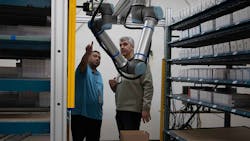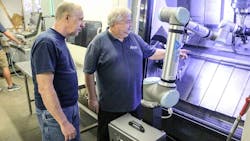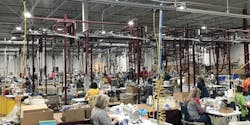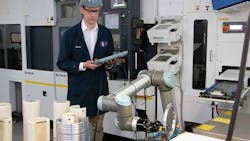Like many companies in the thick of the COVID-19 pandemic, Universal Robots (UR) has seen its growth trajectory stalled. But the collaborative robot (cobot) maker—which leads the industry with more than 46,000 cobots sold globally—continues to look at the market from a long-term perspective because the fundamentals are still there, said Jürgen von Hollen, UR’s president.
Some basic essentials that have been driving the cobot market for years include a lack of skilled labor and a need to improve manufacturing efficiencies to get more out of the assets on hand. If anything, those essentials are even more prevalent within and beyond the pandemic.
Add to that the social distancing requirements in place now, and cobots will likely have even more of a place on production and assembly lines next to workers. It’s also expected that manufacturers will insource through automation in order to mitigate global supply chain risks, von Hollen said. Manufacturers around the world have been trying to figure out what their operations will look like moving forward. “In the post-COVID situation, we’ve seen people and leaders of companies, including ourselves, had to react very quickly,” he noted. “We all do scenario planning, but I don’t think anybody really had a COVID situation in their scenario planning.”
The most resilient businesses—those that can react quickly and adapt their processes to meet changing demands while also protecting workers—will survive the current crisis and others in the future. “The crisis has accelerated the need for flexible automation,” said Joe Campbell, UR’s senior manager of applications development. “We’re seeing an uptick in interest for collaborative robots due to social distancing requirements, reshoring to avoid long supply chains, and the need for rapid production line changeovers.”
But cobots still suffer from an awareness challenge, according to von Hollen. “I still fundamentally believe we’re at the beginning of the growth curve for collaborative robots,” he said, speaking to members of the press leading up to the company’s Cobot Expo, a free online showcase of UR’s products taking place this week, July 28-30. “Our biggest barrier to growth is still awareness.”
Universal Robots is driven by the belief that automation should be accessible by all companies, not just the very large, von Hollen said. “The only way to do that is through collaborative automation. It’s safe, fast, flexible, and easy.”
Collaborative robots have been used in a number of way to help companies react to the pandemic. “People have really come together and have risen to the challenge,” he said. “Our technology is playing an essential role as part of that.”
>>See how mobile robots are being used to disinfect facilities, provide surveillance, material handling, and help with deliveries during the COVID-19 pandemic.
Logistics fulfillment
Instead, DCL quickly deployed an additional UR10e-based fulfillment cell. “The numbers are staggering,” von Hollen pointed out. “Productivity increased by 500%. That’s the typical production of five temporary positions. The ROI for each robot was three months.”
The productivity increase and cost reduction enabled DCL to meet demand without passing price increases on to its customers. It was one of the few fulfillment centers that didn’t change its service-level agreements (SLAs) during the pandemic.
No turning away orders
“It increased productivity substantially,” von Hollen said, noting how the shop owner commented that he should’ve made the move a lot sooner. “Most of these smaller companies never truly believed that automation or collaborative robots would be a fit for them.”
Making masks
They deployed UR-5e cobots to do end-of-line case packing and UR-10e cobots to palletize cases for shipment. “They were able to deploy this within three weeks of the purchase order using their local distributor ACS Alabama,” von Hollen noted.
COVID outbreak
Deploying two UR-10e cobots, each tending two dual-spindle CNC lathes, RCM was able to reduce the number of operators per cell from three to one, good for social distancing.
“They leveraged our online academy for training, getting the existing workforce very quickly up and running on how to program cobots,” von Hollen said.
RCM plans to add more cobots to its operations to increase its ability to compete with overseas manufacturers at a time when shorter supply chains have become critical.
Pandemic accelerates move to digital showcase
Universal Robots has several more examples of its robots being used during the pandemic, von Hollen said. But the crisis has also pushed Universal Robots to be more innovative. This week’s Cobot Expo is a key example. “The COVID crisis has accelerated all our activities,” he said. “We understood that we had to go digital. But nobody understood that we had to do it in three months.”
Attendees of the virtual exhibit will be able to visit booths that feature new insights and resources on the most common cobot applications such as machine tending, packaging and palletizing, product inspection, assembly, welding, dispensing, and finishing. Several keynotes with live Q&A sessions will also offer insights on how to identify good projects, choosing the right cobot model and peripherals, conducting risk assessment, whether to take a DIY approach or go with an integrator, and more. The agenda also includes presentations on cobot maintenance and programming and the ways cobots are being deployed to address the COVID-19 crisis, including area disinfection, the manufacturing of test kits, face shields and ventilators, and in the handling of COVID-19 tests, protecting hospital staff from exposure.
UR+ partner booths will also show off the large ecosystem of products certified to integrate seamlessly with UR cobots. Other booths will be hosted by the Association for Advancing Automation (A3) and OEM partners showcasing products powered by UR cobots.
>>Listen to the latest episode of the "Automation World Gets Your Questions Answered" podcast, in which UR's Joe Campbell talks about how manufacturers are deploying collaborative robots to help restore manufacturing during the pandemic.
>>Subscribe to the popular podcast series to hear answers to more automation technology questions submitted by end users throughout manufacturing.





